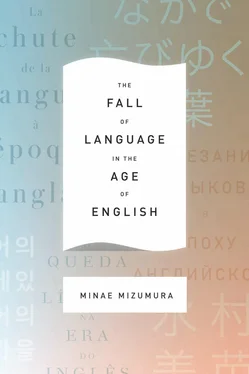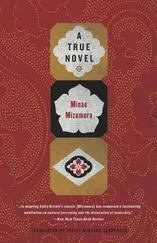As men began to write more freely in hiragana, hiragana writings began to incorporate Chinese characters more freely, increasingly blurring the difference between hiragana-based and katakana-based texts. Some Buddhist writers began using hiragana for their less scholarly works. Then, during the Edo period, with the emergence of protonationalism and a school of thought called kokugaku (national philology), there even appeared some scholarly texts that were hiragana-based. When kokugaku apologists criticized the dominance of “foreign” Chinese learning, they were in fact criticizing the dominance of universal language while using what circulated as merely a local language. In their writings, the local language had become a language that bore intellectual, ethical, and aesthetic burdens, just like the universal language; it had come to function almost like a national language.
Chinese people, proud of their advanced civilization, were highly Sinocentric. They little knew or cared that people across the sea had created their own strange system of writing by using and adapting Chinese characters for their own purposes. They little knew or cared that that system of writing was being used to compose poems about cherry blossoms, autumn leaves, and the transience of life. What they did know was how poor Japanese mastery of the Chinese language was compared with that of Koreans and Vietnamese. Japanese people’s Chinese was generally looked down on inside the Sinosphere, doubtless with good reason.
Yet from a modern historical perspective, the Japanese achievement in developing a local language and literature early on was quite remarkable. The Western experience was different. In medieval Europe, learned bilinguals remained absorbed in the library of the universal language of Latin for a thousand years under the authority of the Church, very much like those absorbed in the Chinese library under the imperial examination system. European vernacular writing started appearing only in the twelfth century and began to flourish from the Renaissance period on: Dante’s Divine Comedy in the early fourteenth century and Chaucer’s Canterbury Tales later that century, followed by François Villon’s poems in the mid-fifteenth century and Shakespeare’s plays in the late sixteenth and early seventeenth centuries. Moreover, all these works — with the exception of some parts of The Canterbury Tales —were poetry or plays, not prose. Not until the seventeenth century did the first pinnacle of prose fiction in the West, Miguel de Cervantes’s Don Quixote , appear — some six centuries after The Tale of Genji .
THE DEVELOPMENT OF CAPITALISM IN THE EDO PERIOD
Let us next briefly touch on the second condition that I believe enabled the Japanese language to quickly establish itself as a national language: the development of what Anderson calls “print capitalism” during the Edo period. However refined, Heian court literature alone, known only to a handful of aristocrats and their entourage, would not have led to the speedy establishment of a national language. What was needed was a thriving bourgeois literature, widely enjoyed by middle-class townsmen.
Under the more than 250 years of peace during the Edo period, Japan, though basically cut off from the rest of the world, enjoyed steady economic growth. Living in a mountainous island country with many rivers and inlets proved handy during the premodern age, when water was the principal means of conducting trade. Added to this topographical advantage was the system called sankin kōtai (alternate residence) by which the Edo shogunate required feudal lords, or daimyo, to reside in Edo and their domain in alternate years: this system created a strong need for cash for the daimyo, to make the costly annual journey and to reside in the capital with style. The Edo period saw increasingly heavy trade between the capital and the provinces as well as among the provinces themselves, and the country soon became the wealthiest in the non-West — though the Japanese had no idea of this. The development of capitalism is always accompanied by a rise in literacy; one must be able to count and read and write to join the marketplace. Thus by the end of the Edo period, the country was filled with schools, including public schools for members of the samurai class and temple schools for children of ordinary people. Japan boasted a literacy rate among the highest in the world. Print technology (mainly woodprint) had existed well before the Edo period, but now the active economy and high literacy rate combined to create Anderson’s “print capitalism.” To be sure, a unified written language did not yet exist. A bewildering variety of forms of written language coexisted. Moreover, none of them was anything close to the spoken language, and there was no such thing as a unified spoken language either. (The diversity of dialects at the time is unimaginable for Japanese today.) And yet Anderson’s point that the development of print capitalism leads to the increased circulation of writings in the local language holds true in Japan, too. The growing market for books came to absorb more and more monolinguals. Indeed, by the time of the Meiji Restoration, Japanese writing was circulating on a scale scarcely seen in any premodern society.
It was against this background that, soon after the Restoration, two books appeared back to back and became Japan’s first best sellers. Self-Help (1859) by Samuel Smiles, a Scottish reformer, was translated and published in 1871, only three years after the Restoration. It became an instant must-read and sold a million copies altogether. Then in the following year came An Encouragement of Learning ( Gakumon no susume ) by Fukuzawa Yukichi (1835–1901), 6an influential educator who played a key role in the Westernization of Japan. (We will be touching on his fascinating autobiography later.) Written in a relatively simple style that Fukuzawa claimed “even a monkey could read,” it was initially published in pamphlet form and sold so well—700,000 copies in all, plus pirated editions that led him to complain about the lack of enforcement of copyright law — that he decided to issue it in book form in 1880. The book went on to sell an astonishing three million copies.
To reiterate, Japan was fortunate first in its geographic position — close enough to China and Korea to receive an early introduction to writing, far enough away for its own indigenous writing to grow and flourish — and second in its economic development, which allowed that writing to spread among the population at large. These were the two conditions, virtually ignored by literary scholars, that made it possible for Japanese to establish itself as a bona fide national language shortly after the Meiji Restoration. However, while these two were prerequisites, they alone were insufficient. For the Japanese language to transform itself into a national language so swiftly, there was yet another, absolutely indispensable, historical condition, one that has been not just ignored but virtually suppressed: Japan had to escape from the Western powers.
THE ESCAPE FROM THE WESTERN POWERS
From the nineteenth century to the twentieth, Western powers spread through Asia and Africa, colonizing nearly all the non-West. Japan, however, managed to escape this fate (though it soon enough turned neighboring nations into colonies of its own). At the time of the Meiji Restoration, non-Western countries besides Japan that were not colonies or protectorates, and also not divided or leased, could be counted on the fingers of one hand. In Eurasia there were Korea, Thailand, Afghanistan, and part of the Ottoman Empire; in Africa — not counting Liberia, founded by freed American slaves with the aid of the U.S. government — there was only Ethiopia. Japan was thus one of the lucky few.
Читать дальше












